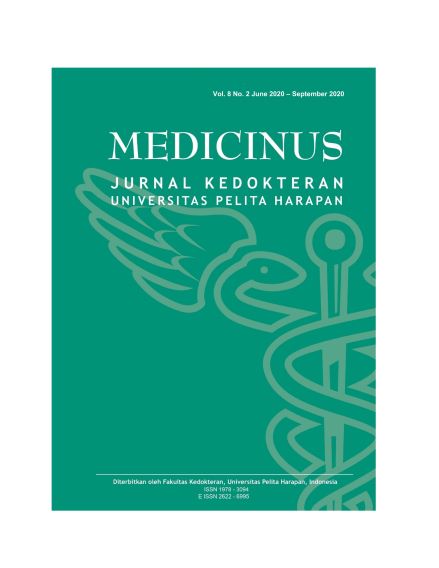Late Intra-Uterine Fetal Demise with Fetal Hydrops: Challenges of Management Planning in Indonesia
DOI:
https://doi.org/10.19166/med.v8i2.3445Keywords:
Intra-Uterine Fetal Demise, Fetal Hydrops, Management PlanningAbstract
Intra-Uterine Fetal Demise (IUFD) is defined as death of human conception at age of 20 weeks’ gestation or older or with a minimum 500-g birthweight before complete delivery from the mother and induced termination involved. In 2015, Indonesia has contributed a stillbirth rate of 13 out of 1,000 total births in which 17.1% of the cases were caused by congenital anomalies. Fetal Hydrops as a pathological condition in which there is an accumulation of fluid in fetal soft tissues and serous cavities. With the advancements of sonographic technology, identification of fetal hydrops has become uncomplicated. However, what remains a challenge is to investigate etiology and determine management. In order to plan proper management, the etiology of fetal hydrops must first be determined to predict the prognosis of fetal hydrops. In Indonesia; limited facilities and experts combined with high costs in etiology determination and management have complicated the matter. Furthermore, the strong influence of several Eastern communities’ norms and religious views have further complicated both physicians and patients in decision making. In this report, we present a case of late intra-uterine fetal demise with fetal hydrops, whom was admitted on her 35 weeks age gestation. We performed elective Caesarean Section in order to deliver the stillborn fetus, with no significant post-operative complication. Unfortunately, this condition was actually diagnosed earlier during 20th weeks of gestation, hence advised to continue the pregnancy without further evaluation and information to the mother regarding the hydrops condition.
References
1. Williams JW, Cunningham FG, Leveno KJ, Bloom SL, Dashe JS, Hoffman BL et al. Williams obstetrics. 24th ed. New York: McGraw-Hill Education; 2014.
2. Maternal and Neonatal Health Disparities Indonesia. UNICEF; 2015.
3. Yeom W, Paik E, An J, Oh S, Choi S, Roh C et al. Clinical characteristics and perinatal outcome of fetal hydrops [Internet]. ogscience.org. 2019 [cited 22 September 2019]. https://doi.org/10.5468/ogs.2015.58.2.90
4. Norton M, Chauhan S, Dashe J. Society for Maternal-Fetal Medicine (SMFM) Clinical Guideline #7: nonimmune hydrops fetalis [Internet]. American Journal of Obstetrics and Gynecology. 2015 [cited 15 September 2019]. https://doi.org/10.1016/j.ajog.2014.12.018
5. Callen P, Feldstein V, Norton M, Scoutt L. Callen's ultrasonography in obstetrics and gynecology. 6th ed. Philadephia: Elsevier; 2017.6. Liao C, Wei J, Li Q, Li J, Li L, Li D. Nonimmune hydrops fetalis diagnosed during the second half of pregnancy in Southern China. Fetal Diagn Ther 2007;22:302-5. https://doi.org/10.1159/000100796
7. Czernik C, Proquitté H, Metze B, Bührer C. Hydrops fetalisehas there been a change in diagnostic spectrum and mortality? J Matern Fetal Neonatal Med 2011;24:258-63. https://doi.org/10.3109/14767058.2010.483522
8. Akar M, Dilli D, Dilmen U. A Case of Nonimmune Hydrops Fetalis Caused by Homozygous α-Thalassemia. Turkish Journal of Hematology. 2013;30(1):63-65. https://doi.org/10.4274/tjh.2012.0021
9. Siswandari W, Rujito L, Indriani V, Djatmiko W. Mentzer Index Diagnostic Value in Predicting Thalassemia Diagnosis. IOP Conference Series: Earth and Environmental Science. 2019;255:012004. https://doi.org/10.1088/1755-1315/255/1/012004
10. Braun T, Brauer M, Fuchs I, Czernik C, Dudenhausen J, Henrich W et al. Mirror Syndrome: A Systematic Review of Fetal Associated Conditions, Maternal Presentation and Perinatal Outcome. Fetal Diagnosis and Therapy. 2010;27(4):191-203. https://doi.org/10.1159/000305096
Downloads
Published
How to Cite
Issue
Section
License
Copyright (c) 2021 Gezta Nasafir Hermawan, Jacobus Jeno Wibisono, Julita D.L. Nainggolan

This work is licensed under a Creative Commons Attribution-ShareAlike 4.0 International License.
Authors who publish with this journal agree to the following terms:
1) Authors retain copyright and grant the journal right of first publication with the work simultaneously licensed under a Creative Commons Attribution License (CC-BY-SA 4.0) that allows others to share the work with an acknowledgement of the work's authorship and initial publication in this journal.
2) Authors are able to enter into separate, additional contractual arrangements for the non-exclusive distribution of the journal's published version of the work (e.g., post it to an institutional repository or publish it in a book), with an acknowledgement of its initial publication in this journal.
3) Authors are permitted and encouraged to post their work online (e.g., in institutional repositories or on their website). The final published PDF should be used and bibliographic details that credit the publication in this journal should be included.





